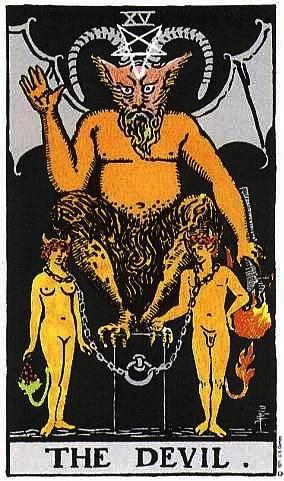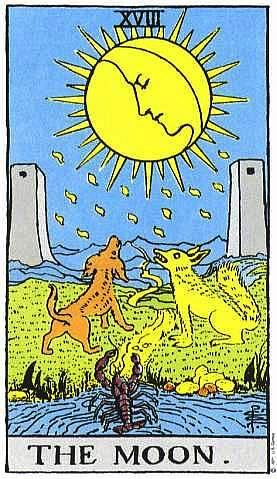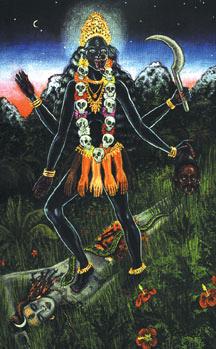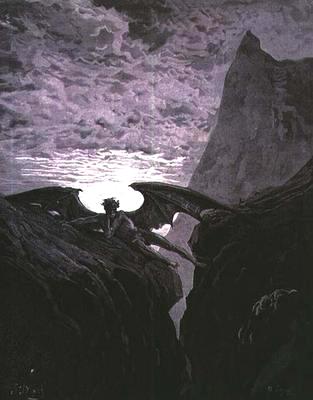|
|
Tavern of Ruin
"In Hindu mythology, this destruction of the "ego," whether as joy or terror,
is represented by
the image of Kali, the goddess-mother who "prepares us for the oneness. Kali is
she who
swallows the universe. She consumes smallness, your pain, your guilt, and
finally your
ego...Kali is the Black Mother, the dark mother of the night. It is she who
kills the ego dead.
(Bhagavati, 1998, p. 18). Kali, seen through the veil of maya, is a terrifying
presence. She is
depicted as surrounded by cremation grounds, dripping blood, wearing a garland
of skulls, a
belt of severed hands, holding a skull cup and a sword. 'She devours pain,
devours truth,
devours falseness, devours all that is and leaves just the purity of the heart'
(Bhagavati, 1998,
p. 18)."
- Madness and Liberation
|
Night
"This is one of the most widely used symbols. "Night" with its connotations of
darkness is used
to denote the unconscious, and of course this stage is a period of intense
unconscious
development, which is experienced in great darkness. The night can also give a
time sequence
to the transcendent journey through the unconscious. The earlier period of dusk
symbolises the
start of circular level and differentiation of unconscious structures. The
later period of dawn
symbolises the ending of this period of differentiation. We are now in this
stage approaching the
darkest most intensive point (i.e. midnight).
The night can also be a symbol of fear, with all kinds of danger lurking.
Likewise, in this
stage, without warning one's peace can suddenly be disturbed and turn to a deep
sense of
unease. This really reflects the tenuous dividing line between nature and
spirit which is especially
thin during this stage. There is never room for complacency. Exposure to pure
spiritual
communication is quickly followed by complementary exposure to human
imperfection."
- Transforming Voyage
- A Contemporary Account of Mystical Personality Development
chapter 9, Black Hole
by Peter Collins
At the beginning of the album Rupert has a horse to transport him about. Here
at the end we have images of "broken ploughs" and "spokeless wheels", both of
which are non-functional and useless. The message here seems to be that Rupert
cannot turn back. He has no choice but to stand and face the inevitable. The
ego has nowhere left to run.
"What is this darkness? What is it called? What is its name?" "It's name means
nothing other than an aptitude
for sensitivity that is not all lacking in or devoid of being. It is rather a
rich sensitivity in which you will be made
whole. For this reason, there is positively no turning back."
- Meister Eckhart
return to page index
site index
"Hides spokeless wheels in shadow."
|
|
"What is the shadow? While Jung finally defined the shadow as "The
thing one has no wish to be," we continue to know it by many names:
the alter-ego, the lower self, the other, the double, the dark twin, the
disowned self, the repressed self, the id, etc. We speak of "meeting our
demons," "wrestling with the devil," ("the devil made me do it"), a
"descent to the underworld," a "dark night of the soul," a "midlife
crisis." The shadow abounds in the classic human stories: it is a Grendl
to his Beowulf, Shakespeare's Macbeth to his more noble Hamlet,
Mephistopheles in dialogue with Faust, Darth Vader (the "dark father")
in battle with his ego-heroic son, Luke Skywalker.
Here we begin to see the mythic proportions of the shadow concept, the
archetypal Shadow, the reality of evil. Just as we each contain a
potential murderer or suicide as an inherent mode of human behavior,
so the denied shame and rage of an entire generation can be
released——through participation mystique——and engulf us all. We
recognize the archetypal shadow in the great stories of humanity: now
as the devil, here as Shiva, there as Loki, Beelzelbub, and in the
alchemists' sol niger (black sun). Freud called it Thanatos, the death
instinct. Both Freud and Jung recognized this archetypal force as
something which is simply there and cannot be rationalized away."
|
- The Shadow in America
The Devil Tarot Card
"The Devil represents the Shadow, and this trump heralds a confrontation with
the Shadow.
 There is tendency in the Western tradition to consider the Shadow to be the
source of all evil, but it "also
displays a number of good qualities, such as normal instincts, appropriate
reaction, realistic insights, creative
impulses, etc." (Jung, CW 9 ii, par. 423). Thus, the challenge of 14.Diabolos
is not to defeat the Devil within, but to
confront it and to integrate its powers and strengths into the Self - to bring
the Devil into our service. Such a
confrontation is necessary if we are to become truly human, for if we do not
acknowledge the Shadow, then we
project it onto external reality, especially upon other people. That is, we
make someone or something a
scapegoat (which leads us to Pan). To be complete, all parts of the psyche must
be accepted."
There is tendency in the Western tradition to consider the Shadow to be the
source of all evil, but it "also
displays a number of good qualities, such as normal instincts, appropriate
reaction, realistic insights, creative
impulses, etc." (Jung, CW 9 ii, par. 423). Thus, the challenge of 14.Diabolos
is not to defeat the Devil within, but to
confront it and to integrate its powers and strengths into the Self - to bring
the Devil into our service. Such a
confrontation is necessary if we are to become truly human, for if we do not
acknowledge the Shadow, then we
project it onto external reality, especially upon other people. That is, we
make someone or something a
scapegoat (which leads us to Pan). To be complete, all parts of the psyche must
be accepted."
- The Pythagorean Tarot by John Opsopaus
Archetypes and the Individuation Process
"According to Jung, one must get in touch with the Shadow and Anima/Animus
before one can truly get
in touch with the Self. The order is sequential, and as tempting as it may be
to try and skip the Shadow
or deal only superficially with it, it is here that we begin.
Jung referred to this initial step as "the First Act of Courage". And the first
thing that is necessary in
coming to terms with one's own shadow is simply to acknowledge that it exists.
It sounds obvious, but
there are those for whom the thought of actually having a darker side to their
nature is extremely
uncomfortable. Yet this is one of the primary reasons for undertaking the
'Shadow work' in the first
place, since that which we have yet to disavow in ourselves will be projected
outwards."
- Process of Individuation
"Sentries lean on thorn wood spears
Blow on their hands, stare eastwards.
"Thorn wood spears" suggest a crucifixion (crown of thorns, wooden cross, spear
in the side). Significantly, the forces of the ego "stare eastwards" towards
Intuition, the enemy camp.
"Burnt with dream and taut with fear
Dawn's misty shawl upon them.
Three hills apart great armies stir"
The "three hills apart" are the three psychological functions, Thinking,
Feeling and Sensation differentiated from the whole.
"Spit oath and curse as day breaks.
Forming lines of horse and steel
By even yards march forward."
"The tendencies and habits of lifetimes do not easily melt away under
the heat of religious fervour. As the pilgrim-soul approaches the gateway
to the arduous spiritual path, all which must perish in the divine fire
precipitates the conflict between the aspirant's will to merge in the
universal light and all temporal traits."
- The Hero in Man
"In order to attain the spiritual heights, every initiate must go down into the
depths and
go through a period known as 'the dark night of the Soul', which may last
months and
months. This is a time of anguish, a period of barrenness in which he is torn
apart and
feels certain that God has forsaken him, that he is unworthy, that he has made
a mistake,
or that he has committed a sin, and God has therefore cast him into outer
darkness. The
reason for this desolation is not that God has thrown him off: it is only that
a greater,
deeper light is coming, and there must be an emptying-out process before that
greater
light can come."
"There wil be an overturning in our consciousness, and it will appear to us as
a warfare
between the flesh and the Spirit, a warfare between disease and health, between
lack and
abundance, and finally between the two I's: the I that we are as a person and
the I that
is God. (...) the warfare goes on until finally that human being is shaken so
thoroughly
that he awakens to the fact that of himself he is nothing, but that the I which
is God is
all."
- A Parenthesis in Eternity. Living the Mystical Life
return to page index
site index
 "In 17.Moon we make our final descent to the Underworld, and have our final
confrontation with the monsters of
the collective unconscious.
"In 17.Moon we make our final descent to the Underworld, and have our final
confrontation with the monsters of
the collective unconscious.
"Old moon-light stalks by broken ploughs
Hides spokeless wheels in shadow."
"In this trump the scene is flooded by lunar illumination, which is the
reflected light of the unconscious. This
illumination is feminine, indeed, virginal, for the moon always keeps one face
hidden. It reveals things in a
different way than the harsh, masculine, solar illumination encountered in
18.Sun, for moonshine blends and
hides distinctions; it exhibits interconnection.
After passing this "dark night of the soul" to the satisfaction of Mistress
Moon, the
Queen of the Night, we shall be reborn from the watery womb, and will be given
the opportunity to cross this
uncanny desert, and if we escape its dangers we will come to the fiery garden
of the Sun (see 18.Sun).
(Nichols 313-4; O'Neill 389; Sharman-Burke 110) Thus, in the Rosarium (1593)
the Sun says: "in my sister the
moon the degree of your wisdom increases, and not with another of my servants,
even if ye know my secret"
(Jung, MC 138).
Immersion in the briny Ocean brings about the alchemical dissolution, the
"trial by
bitter waters
," and in their murky depths we experience the "dark night of the spirit."
There, like every
shaman initiate, we suffer complete dismemberment; we are served as a feast for
the gods. It is terrifying, but
the ultimate adventure. (Crowley 113; Gad 276; O'Neill 389)"
- The Pythagorean Tarot by John Opsopaus
"The 'mystic death' or Dark Night is therefore an aspect or incident of
the transition from multiplicity to Unity, of that mergence and union of
the soul with the Absolute which is the whole object of the mystical
evolution of man. It is the last painful break with the life of illusion, the
tearing away of the self from that World of Becoming in which all its
natural affections and desires are rooted, to which its intellect and
senses correspond; and the thrusting of it into that World of Being
where at first, weak and blinded, it can but find a wilderness, a "dark."
No transmutation without fire, say the alchemists: No cross, no crown,
says the Christian.
...Here as elsewhere--but nowhere else in so drastic a sense--
the self must "lose to find and die to live."
- Mysticism - The Dark Night of the Soul"
Sign
the Dreambook
 Read
the Dreambook
Read
the Dreambook

Return to the Song Soup On Sea Homepage
These Pages Created
and Maintained using
 Arachnophilia
Arachnophilia
Copyright
© 1998 - 2001 ~ Jon Green /All rights reserved
|


























